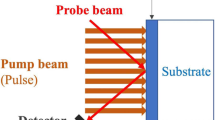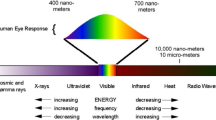Abstract
Developing efficient methods for evaluating resonance characteristics of resonance structures is of particular importance in sensing, spectroscopy, and optical filtration. In the past, the resonance characteristics were evaluated using exact approaches with time-consuming data post-processing algorithms. In this work, using the Fano approximation of the resonance line shapes appearing in spectra of planar plasmonic structures, we obtain analytical expressions for the surface field enhancement, resonance width and height, and sensitivity as functions of structural optical parameters. Approximate data for three-layer Au-, Ag-, Cu-, and Al-based structures in aqueous environment are compared with exact values to estimate the approximation error in the visible and infrared regions. We obtain overall good fits of the approximated estimations to the exact data over the wavelength regions considered, which ensure the validity of the Fano-based approach. Furthermore, by applying the Fano-based approach to gas sensing, we demonstrate that in the angular spectra of the three-layer structures, the excitation of propagating plasmons in the infrared region leads to narrower resonance line shapes due to the decrease in the plasmonic mode damping, resulting in higher sensitivities to changes in air environment. The Fano-based expressions tangibly increase the speed of calculations, provide an insight into fundamental aspects of resonance physics, and can be used for designing efficient sensing structures and characterizing optical changes in the environment.









Similar content being viewed by others
Data Availability
The data that support the findings of this study are available from the corresponding author upon reasonable request.
References
Nylander C, Liedberg B, Lind T (1982) Gas detection by means of surface plasmon resonance. Sensors Actuators 3:79–88
Homola J (2008) Surface plasmon resonance sensors for detection of chemical and biological species. Chem Rev 108:462–493
Meyer SA, Le Ru EC, Etchegoin PG (2011) Combining surface plasmon resonance (SPR) spectroscopy with surface-enhanced Raman scattering (SERS). Anal Chem 83:2337–2344
Elhani S, Ishitobi H, Inouye Y, Ono A, Hayashi S, Sekkat Z (2020) Surface enhanced visible absorption of dye molecules in the near-field of gold nanoparticles. Sci Rep 10:3913
Zhu T, Zhou Y, Lou Y, Ye H, Qiu M, Ruan Z, Fan S (2017) Plasmonic computing of spatial differentiation. Nat Commun 8:1–6
Ashwell G, Roberts M (1996) Highly selective surface plasmon resonance sensor for NO2. Electron Lett 32:2089–2091
Lang T, Hirsch T, Fenzl C, Brandl F, Wolfbeis OS (2012) Surface plasmon resonance sensor for dissolved and gaseous carbon dioxide. Anal Chem 84:9085–9088
Manera MG, Montagna G, Ferreiro-Vila E, González-García L, Sánchez-Valencia J, González-Elipe AR, Cebollada A, Garcia-Martin JM, García-Martín A, Armelles G (2011) Enhanced gas sensing performance of TiO2 functionalized magneto-optical SPR sensors. J Mater Chem 21:16049–16056
Berrier A, Offermans P, Cools R, van Megen B, Knoben W, Vecchi G, Rivas JG, Crego-Calama M, Brongersma SH (2011) Enhancing the gas sensitivity of surface plasmon resonance with a nanoporous silica matrix. Sensors Actuators B Chem 160:181–188
Maharana PK, Jha R, Padhy P (2015) On the electric field enhancement and performance of SPR gas sensor based on graphene for visible and near infrared. Sensors Actuators B Chem 207:117–122
Miwa S, Arakawa T (1996) Selective gas detection by means of surface plasmon resonance sensors. Thin Solid Films 281:466–468
Petty M (1995) Gas sensing using thin organic films. Biosens Bioelectron 10:129–134
Ignac-Nowicka J, Pustelny T, Opilski Z, Maciak E, Jakubik WP, Urbanczyk MW (2003) Examination of thin films of phthalocyanines in plasmon system for application in NO2 sensors. Opt Eng 42:2978–2986
Yang D, Lu HH, Chen B, Lin CW (2010) Surface plasmon resonance of SnO2/Au Bi-layer films for gas sensing applications. Sensors Actuators B Chem 145:832–838
Herminjard S, Sirigu L, Herzig HP, Studemann E, Crottini A, Pellaux JP, Gresch T, Fischer M, Faist J (2009) Surface plasmon resonance sensor showing enhanced sensitivity for CO2 detection in the mid-infrared range. Opt Express 17:293–303
Herminjard S, Crottini A, Vaccaro L, Herzig H, Studemann E, Nicolle G (2006) Surface plasmon waveguide resonance spectroscopy applied on food dyes solutions under anomalous dispersion. Proc. EOS Topical Meeting on Molecular Plasmonic Devices, 1, 13, Engelberg, Switzerland, pp 3–4
Shin W, Matsumiya M, Qiu F, Izu N, Murayama N (2004) Thermoelectric gas sensor for detection of high hydrogen concentration. Sensors Actuators B Chem 97:344–347
Takeuchi K, Tanaka T, Ikeda M, Shibata K, Sakauchi Y, Yamada Y, Nakano S (1993) Highly accurate CO2 gas sensor using a modulation-type pyroelectric infrared detector. Jpn J Appl Phys 32:221
Nesterenko DV, Pavelkin RA, Hayashi S, Soifer VA (2019) Analysis of the resonance characteristics of surface plasmon polariton modes at air-metal interfaces in the ultraviolet, visible and infrared regions. J Phys Conf Ser 1368:022062
Nesterenko DV, Hayashi S, Sekkat Z (2016) Extremely narrow resonances, giant sensitivity and field enhancement in low-loss waveguide sensors. J Opt 18:065004
Hayashi S, Fujiwara Y, Kang B, Fujii M, Nesterenko DV, Sekkat Z (2017) Line shape engineering of sharp Fano resonance in Al-based metal-dielectric multilayer structure. J Appl Phys 122:163103
Shalabney A, Abdulhalim I (2011) Sensitivity-enhancement methods for surface plasmon sensors. Laser Photonics Rev 5:571–606
Homola J, Koudela I, Yee SS (1999) Surface plasmon resonance sensors based on diffraction gratings and prism couplers: sensitivity comparison. Sensors Actuators B Chem 54:16–24
Johansen K, Stålberg R, Lundström I, Liedberg B (2000) Surface plasmon resonance: instrumental resolution using photo diode arrays. Meas Sci Technol 11:1630–1638
Raether H (1988) Surface plasmons on smooth and rough surfaces and on gratings. Springer-Verlag, Berlin Heidelberg, Berlin
Ruan Z, Wu H, Qiu M, Fan S (2014) Spatial control of surface plasmon polariton excitation at planar metal surface. Opt Lett 39:3587
Kurihara K, Nakamura K, Suzuki K (2002) Asymmetric SPR sensor response curve-fitting equation for the accurate determination of SPR resonance angle. Sensors Actuators B Chem 86:49–57
Knobloch H, Brunner H, Leitner A, Aussenegg F, Knoll W (1993) Probing the evanescent field of propagating plasmon surface polaritons by fluorescence and Raman spectroscopies. J Chem Phys 98:10093–10095
Knobloch H, Knoll W (1991) Raman-imaging and -spectroscopy with surface plasmon light. J Chem Phys 94:835–842
Nesterenko DV, Sekkat Z (2013) Resolution estimation of the Au, Ag, Cu, and Al single- and double-layer surface plasmon sensors in the ultraviolet, visible, and infrared regions. Plasmonics 8:1585–1595. https://doi.org/10.1007/s11468-013-9575-1
Nesterenko DV, Hayashi S, Sekkat Z (2018a) Asymmetric surface plasmon resonances revisited as Fano resonances. Phys Rev B 97:235437. https://doi.org/10.1103/PhysRevB.97.235437
Nesterenko D, Pavelkin R, Hayashi S, Soifer V (2020) Analysis of resonance characteristics of surface plasmon-polariton modes at water-metal interfaces by Fano approximation. J Phys: Conf Ser 1461:012115
Nesterenko DV, Pavelkin RA, Hayashi S (2019) Estimation of resonance characteristics of single-layer surface-plasmon sensors in liquid solutions using Fanos approximation in the visible and infrared regions. Comput Opt 43:596–604
Kretschmann E, Raether H (1968) Notizen: radiative decay of non radiative surface plasmons excited by light. Z Naturforsch A 23:235437
Novotny L, Hecht B (2006) Principles of nano-optics. Cambridge University Press, New York
Nesterenko DV, Hayashi S, Sekkat Z (2018b) Coupled-mode theory of field transfer processes in surface plasmon resonance structures. J Phys Conf Ser 1092:012097
Piliarik M, Homola J (2009) Surface plasmon resonance (SPR) sensors: approaching their limits? Opt Express 17:16505–16517
SCHOTT Zemax catalog 2017–01–20b. http://www.schott.com/advanced_optics/english/download/. Accessed 10 Jan 2020
Palik ED (1998) Handbook of optical constants of solids. Academic press, Boston
Rakic AD (1995) Algorithm for the determination of intrinsic optical-constants of metal-films—application to aluminum. Appl Opt 34:4755–4767
Johnson PB, Christy R-W (1972) Optical constants of the noble metals. Phys Rev B 6:4370
Segelstein DJ (1981) The complex refractive index of water. MS thesis (University of Missouri)
Katsidis CC, Siapkas DI (2002) General transfer-matrix method for optical multilayer systems with coherent, partially coherent, and incoherent interference. Appl Opt 41:3978–3987
Querry MR (1987) Optical constants of minerals and other materials from the millimeter to the ultraviolet. Chemical Research, Development & Engineering Center, US Army Armament Munitions Chemical Command, Kansas City
Funding
This research was funded by Ministry of Science and Higher Education of Russian Federation (State assignment to FSRC “Crystallography and Photonics” RAS) and by Russian Foundation for Basic Research (project numbers 18-29-20006 and 18-07-00613).
Author information
Authors and Affiliations
Contributions
Conceptualization, data curation, and methodology, D.N.; investigation, formal analysis, software, visualization, writing—original draft preparation, writing—review and editing, R.P. and D.N.; supervision and revision of the manuscript, validation, S.H., Z.S., and V.S. All authors have read and agreed to the published version of the manuscript.
Corresponding author
Additional information
Publisher’s Note
Springer Nature remains neutral with regard to jurisdictional claims in published maps and institutional affiliations.
Rights and permissions
About this article
Cite this article
Nesterenko, D., Pavelkin, R., Hayashi, S. et al. Fano Approximation as a Fast and Effective Way for Estimating Resonance Characteristics of Surface Plasmon Structures. Plasmonics 16, 1001–1011 (2021). https://doi.org/10.1007/s11468-020-01364-8
Received:
Accepted:
Published:
Issue Date:
DOI: https://doi.org/10.1007/s11468-020-01364-8




